 [Table of Contents]
[Table of Contents]People
old and young enjoy waxing nostalgic about and learning some of the history of
early electronics. Popular Electronics was published from October 1954 through April 1985. All copyrights (if any) are
hereby acknowledged.
See
Popular Electronics articles
on aircraft modeling. See all articles from
Popular Electronics.
|
Beginning with the first edition of the newly
published hobby magazine called "Popular Electronics," the editor thought that including articles
of the relatively new field of radio controlled aircraft would be important to serving a broad spectrum
of interests. In this October 1954 edition, Volume 1, Number 1, prolific model aviation author William
(Bill) Winter provided the write-up below as an introduction to the sport of radio controlled models.
He included material on both airplanes and boats. Of course at the time all the radio equipment used
tubes as the active devices, since transistors were little more than a curiosity to most electronics
tinkerers since they first were announced at Bell Labs in December of 1947. The old tube transmitters
and receivers need to be tweaked and tuned meticulously with each flying session. Engines were very
unreliable for the most parts, and the non-proportional control throws (full left, full right, or neutral)
made the models "gallop" all over the skies.
See complete list of Popular Electronics
articles on aircraft modeling.
Radio Control of Models
By William Winter
Editor, "Model Airplane News"
 One of the most interesting
ramifications of the Citizens Radio Service, created by the Federal Communications Commission a few
years after the war, has been the sensational growth of the radio-controlled plane and boat hobby. Operating
on two examination-free frequencies of 465 and 27.255 megacycles, tens of thousands of radio-control
fans assemble every weekend on fields, farms, and airports to put aloft their small planes. Many a lake
or park pond supports a motley fleet of boats including scale Chris-Craft, tugs, PT's, Mississippi
stern-wheelers, and roaring outboards. Grocery clerk, engineer, architect, airline pilot, school boy
- everybody is doing it. One of the most interesting
ramifications of the Citizens Radio Service, created by the Federal Communications Commission a few
years after the war, has been the sensational growth of the radio-controlled plane and boat hobby. Operating
on two examination-free frequencies of 465 and 27.255 megacycles, tens of thousands of radio-control
fans assemble every weekend on fields, farms, and airports to put aloft their small planes. Many a lake
or park pond supports a motley fleet of boats including scale Chris-Craft, tugs, PT's, Mississippi
stern-wheelers, and roaring outboards. Grocery clerk, engineer, architect, airline pilot, school boy
- everybody is doing it.
 Spot
landing by radio-controlled model. It has 5-channel receiver controlling unit.
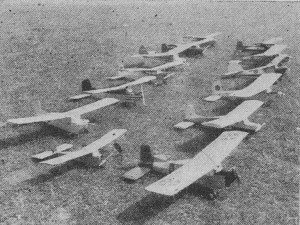 These
planes turned out at the first flying session last Spring of the Buffalo Bisons model airplane club.
Sizes varied from 4 1/2 to 5 feet.
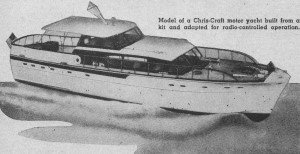
Model
of a Chris-Craft motor yacht built from a kit and adapted for radio-controlled operation.
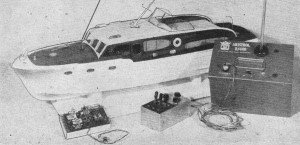
Radio
controlled boat built from kit. The control is a three-channel unit.
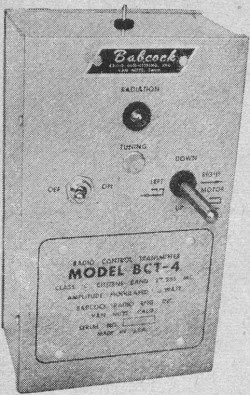
Radio-control transmitter which operates on the 27.255 mc. band.

Companion radio-control receiver made by Babcock Radio Engineering.
Inc., of Van Nuys. Metal "tubes" are sealed relay units.
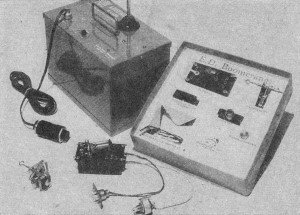 One of
the transmitters and receivers currently on the market. Receiver is 1-tuber.
Catering to this fast-growing hobby are some two dozen manufacturers of transmitters and receivers,
of airplane and boat kits, of escapements, servos, and accessories. Many of the nation's 10,000
hobby shops stock these items. "Radio Row" advertisers offer electronics kits, meters, power
packs, storage batteries, dynamotors - things that once were considered the hams' private domain.
One of Uncle Sam's biggest suppliers of electronic equipment for guided missiles, offers one- and
three channel equipment exclusively to modelers. Complete with radio, a model may cost anywhere from
$20 to $400, depending on its size and capabilities.
Considering the ultimate simplicity of his equipment, the radio control plane builder works wonders.
He is limited by the FCC to an input of five watts maximum to the last stage of his transmitter. What
he gets out of his transmitter is anybody's guess but, if it is tuned properly, it has, perhaps,
as much as 1 1/2 to 2 watts output.
His receiver may be two or three inches square, consisting of a relay, a tube, a tank coil, perhaps
a quench coil, and a few resistors and capacitors. Nevertheless, he blithely sends out his plane to
the limits of vision, a sight which makes any visiting ham turn pale. The ham who joins in the fun,
usually turns up with a 25- to 40-watt transmitter, and then flies the plane in circles around his head!
Most of the transmitters are simple, single-tube, crystal-controlled affairs. They usually operate
on straight continuous wave, or "c.w." Some are two tubers of the "m.o.p.a." type
(master oscillator-power amplifier). Still others use audio, imposing from one to six modulated tones
upon the carrier wave to operate multiple controls, such as elevators or engine speed on a plane, or
horn, throttle, reverse, on a boat. Probably nine out of ten hobbyists operate c.w. (continuous wave).
Signals are transmitted to the plane or boat by means of a keying switch in the "B-plus" lead
of the transmitter. The switch simply closes the circuit and the signal goes out.
Simple electronic or mechanical pulsing devices exist which vary either, or both, pulse rate and
pulse length to accomplish a proportional rudder effect, plus a second control, with but single-channel
radios.
When a signal is detected, the resulting change in the amount of current flowing through the tube
in the receiver is used to operate a relay which, in turn, completes an electrical circuit to the escapement,
servo, or other actuating device to move the control surfaces. The most widely used actuator is the
escapement. This is an electromechanical device which takes its driving power from a twisted rubber
band motor. When current flows through the coil of the escapement, its armature pulls in, releasing
a revolving arm whose movement displaces the control surface via a steel wire linkage. Many types of
escapements are on the market including several imported models.
Most typical is the self-neutralizing escapement. As long as current flows in this escapement it
holds the control hard over but, when the current is cut off, the escapement and control automatically
return to a neutral position. Thus, the amount of turn imparted to the vehicle is governed by the length
of time the operator keeps the keying switch closed. Another escapement, the compound type, will give
one control position on one signal, another on two, and a third on three, and always return to the same
neutral position.
The real miracle is the amazing maneuvers that are performed with this rudimentary equipment. With
rudder only, the pilot performs spirals, zooms, wingovers, lazy eights, Immelmanns, and loops. With
the compound escapement, dives, consecutive loops, and, perhaps, inverted flight becomes possible. When "deluxe"
multichannel equipment comes into the picture, the more skilled fliers do outside loops, inverted turns,
horizontal and vertical eights, and other maneuvers formerly possible only with captive-type models
on the ends of control wires .
The planes themselves may be original, that is, designed by the builder, or they may be assembled
from anyone of several dozen kits. Size varies from 3 to 9 feet, but 4 1/2 feet is the popular average.
Weighing 2 1/2 to 3 1/2 pounds, the typical plane is powered with a two-cycle, glow-plug engine (or
perhaps a Diesel) of from .09 to .15 cubic inch displacement. Other planes may have power plants of
from .030 to 1.25 cu. in. displacement. The planes are of balsa wood, covered with tough paper, silk,
or nylon. Speed varies from 15 to 40 mph in level flight, depending on the plane's size, weight,
and power.
Boats are constructed in an infinite number of sizes and types. Engine manufacturers have lately
turned out an intriguing variety of power plants, ranging from beautiful scale-model outboards of only
.049 displacement (and do these kick up a storm in a test barrel!) through water-jacketed inboard types
to deluxe numbers with all the gadgets and gismos such as water pumps. Yet some boat fans stick to sail
- and wouldn't you expect it!
Now that the "R/C" fans have a few years' experience under their belts, more of them
are eyeing the multichannel radios newly-available at the hobby shops. So far it is a toss-up between
proponents of the "reed bank jobs" and those of the bandpass or filtered receivers which electronically
direct the particular tone detected to an appropriate relay and control surface. In the reed bank, one
of the three to six or more reeds become agitated in response to its particular tone and then operates
a relay.
Under the guidance of the Academy of Model Aeronautics, the national rules-making and record-keeping
body, rules and procedures have been developed for radio-control contests. At small contests a precision
type of pattern is flown, consisting of a take-off, 500 feet straightaway, a 90 degree left turn, a
270 degree right turn, straight flight back to the transmitter, followed by an S-turn, pylon eight,
rectangular pattern, and a spot landing. Sometimes a stunt pattern is flown as well. Other than take-off
and spot landing, the maneuvers are limited only by the flier's imagination and pocketbook. The
National Contest radio control event was won in 1953 by an airplane having rudder control only.
Not to be outdone by his aeronautical cousin, the "RC" boat builder has his own contests
with a rather difficult pattern to steer through marking buoys. Plane and boat fans both are organizing
clubs by the hundreds.
The radio control hobby is international. Western European nations gather for team competition every
year. The Federation Aeronautique Internationale, with headquarters in Paris, confirms all full scale
as well as model plane international records. One duration mark has been bitterly contested between
Russia, Great Britain, and America. British hobbyists sent a radio-controlled boat across the Channel.
It fared better than the queasy crew of the following boat. There's a distance record where the
model must be kept in sight, without judges or pilot leaving the launching site. Pylon closed-course
races have been held - everyone agreed that man is a terrible judge of distance! Radio-controlled models
have towed gliders, carried movie cameras (the color film might have been taken from an airliner, so
well did it turn out), flown the Detroit River to Canada in public demonstration, the Potomac with a
pay load of silver dollars on Washington's birthday (the wrong river, 'tis true).
Occasionally, of course, such a model gets away from its master, usually with comic results. If he
has put too much gas in the tank, the flier is led a merry chase by automobile. Small boys may hold
the plane for ransom. But even when the plane comes down far afield, the canny hobbyist has a trick
or two up his sleeve. Since the receiver broadcasts mildly on its own, while the batteries last, he
may carry a special receiver to detect the model up in some tall tree, or hidden between rows of corn.
An errant flight is the exception and not the rule.
Ninety-nine times out of 100, the model can be landed nearby. That the flier gets a bang out of every
flight and landing is obvious. What is not so apparent is the business created or, what is even more
important, the widening appreciation of electronics by so many people, thanks to the cooperation of
the FCC!
END
Posted September 3, 2011
Vintage Popular Electronics Magazine Articles
- R/C Notes, January
1956
- R/C Triplex: Three Controls on One Channel,
November 1956
- R/C Reliability,
March 1955 Popular Electronics
-
Robot Helicopter, November 1956
-
Model Boat for the 27 mc. Citizens Band , March 1953 Radio & Television News
- Adjusting
the Power - R/C Plane, January 1955
- Rejuvenate
R/C Batteries, July 1955
- 3 and 4 Finger
R/C Escapements, January 1955
- Radio Control
of Models, October 1954
- The R/C Cloud, February 1960
- Radio
Control Installations, February 1955
-
Compound
Escapements & Servos, February 1955
- Flying the R/C
Plane, December 1954
- The Lorenz
Transmitter, December 1954
|